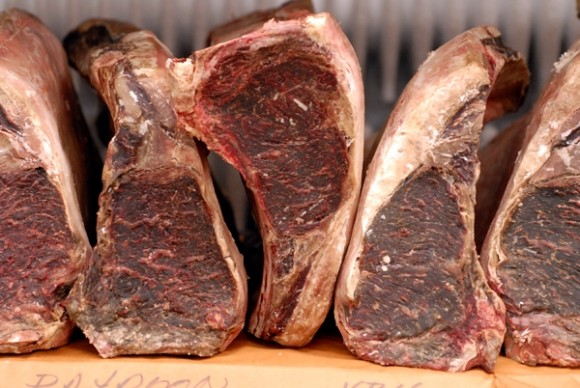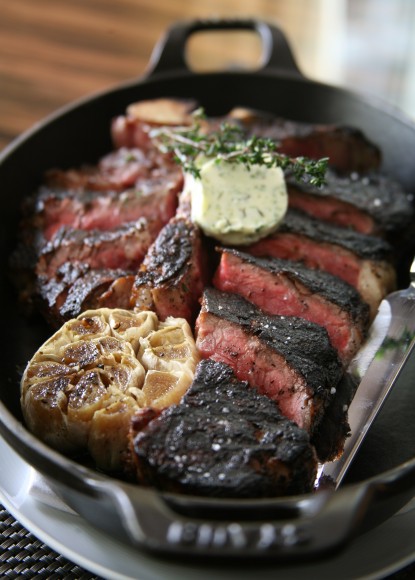By Vincenza Di Maggio

Our national culinary identity is all wrapped up in meat.
Meat has taken on such a prominent role in the American diet that it’s become so ingrained into our national identity that most Americans, when eating a steak or biting into a juicy cheeseburger on any given day of the week don’t give this delicious luxury a second thought.
But it’s worth some consideration as evidenced by the fact that restaurant consultant Clark Wolf recently convened a whole panel of experts to discuss this very topic. Wolf notes, “The drought in Texas causing prices to rise, a greater basis of sustainability in animal practice, a strong interest in community husbandry, and the start of the holiday season make this [American’s consumption of meat] an important timely topic.”
He continues, “In a different economy our iconic protein warrants discussion. Our job is to highlight the many viewpoints not always addressed.
Wolf led the spirited discussion titled “The Changing Center of the American Plate” at New York University’s Fales Library. Joining him was Jenifer Harvey Lang, food journalist and Managing Director of the renowned Café des Artistes in Manhattan, Dr. Marion Nestle, the Paulette Goddard Professor of Nutrition, Food Studies and Public Health at New York University, Jeffrey Yoskowitz, writer and self-proclaimed Semitic Swinologist, Mark Gilman, cheese maker, and Betty Fussell, Food Historian & Author of Raising Steaks: The Life and Times of American Beef.
The participants each brought an original perspective to the table, and approached the topic from various angles, making for a very free-form dialogue.
Dr. Marion Nestle, known for her role as a driving force in the food industry, notes that meat consumption is directly related to the economic stability of a country; something that America has enjoyed a lot of over the years. She says, “American steak is here to stay. It’s iconic and you don’t bring down icons.” This is not only true of beef but also of pork. The pig, an animal whose meat is valued for its nutritional value and savory taste, is an iconic American animal as well.
Connecting to American food icons takes many forms. Though pork is not an acceptable meat in the Jewish culinary repertoire, panelist Jeffrey Yoskowitz appreciates the cultural impact the “other white meat” has in American society. He notes that soy pork alternatives have become popular among observant Jewish diners, as he says, “It’s not because people want to eat pork, but because people want to feel a part of America. They want to feel a part of something greater than themselves.” The consumption of soy meat products reaches as far back as the 1920’s with the invention of beef fry – essentially a beef version of bacon. Yoskowitz says, “It was popular because it was an attempt to bring eating like an American – eggs and meat at breakfast – to the Jewish public.”
Meat plays such a prominent role in American food culture that Yoskowitz says, “A lot of Americans can’t imagine a meal without it.” Eating like an American, with a high level of meat consumption is something new for immigrants to the United States who previously were in the habit of reserving meat for special occasions. Yoskowitz comments, “Immigrants from Ireland, Italy, and the Jewish communities in Eastern Europe came here and adapted to American food culture. Those who used to eat meat once a week, now, living in America are eating it once or twice a day.”
Despite the fact that meat consumption is up to once or twice a day among many diners Yoskowitz anticipates a waning in American meat consumption due to recent economic declines, but considers this to be a positive change. Betty Fussell disagrees. Her book, which covers the history of the beef industry in the United States, outlines a different scenario. Fussell believes that despite economic declines, American beef consumption will not decrease, but instead, due to recent efforts put towards ethical animal sustainability practices and she remarks, “Meat is making a comeback, even among some vegetarians.”
Fussell continues, “I have been keen on getting the meat message out for the last few years when it became increasingly clear that to continue the factory production of meat as we’ve been doing is self-destructive in many ways and certainly not sustainable for anybody. Or anything. Including the animals we’ve been manipulating as if they were things. We are in the midst of a revolution. The old system is running out of steam while new movements, like the Green Movement, begin to pick up steam.”
The revolution isn’t just happening on the plate; according to Lang, the plate itself is part of the revolution and pointed attention to how it has grown in size over the decades. Lang says, “In the 1950’s the average dinner plate was 9 inches, in the 1980’s it was 11 inches, and now it is 13 inches. An 11 inch plate has 60% more room on it then a 9 inch plate, and a 13 inch plate has double the amount of space for food then it did in the 1950’s.” The growing size of the dinner plate indicates an obvious change in American eating habits; yet, despite there being more room on the plate for vegetables and starches, meat continues to take center stage.
Whether they eat pork, or not, and agree or disagree on the politics of beef production and consumption, one thing was crystal clear at the end of this discussion, meat has taken on a larger identity then just acting as America’s source of protein. The panelists all agree with Wolf who concludes, “There is a place American steak has in our psyche.”


